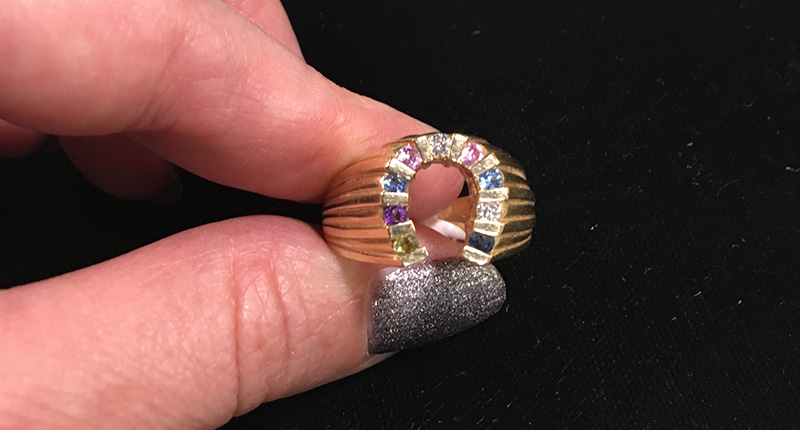5 Tips for Buying Antique and Estate Jewelry

When possible, Richardson said, try on the jewelry to see if its lays right and is comfortable. “If something doesn’t work, factor that into negotiating the price,” she said.
2. If it’s old, it should look it.
While Rother’s immediate answer to my question about spotting reproductions was “experience,” he did allow that there are a few obvious signs that a piece is not as old as advertised, chief among them being no signs of wear.
If, for example, there are loops connecting two gemstones in an earring, there should be a small groove where the loops connect. Pointing to the necklace I was wearing that day, a gold medallion passed down to me by my grandmother, he noted that I would see the same on the bail.
Khan Ismael, an independent British dealer working at the booth of Lowther Antiques, said to check the prongs to see if they show signs of wear and, also, to look at the enamel. If a piece of jewelry is supposed to be 200 years old and the enamel is pristine, then something is off.
He added that weight and size also are good indicators of age.
A lot of older jewelry—Georgian chain, for example—was very light.
Antique cuffs are often small because people had smaller wrists, while antique rings tend to the extremes.
They are either small (because, again, people were smaller) or large because they were made to be worn over gloves. It is unusual, he said, to be able to get antique rings in the average rings sizes of today, like a 6 or a 7.
3. Money, money, money.
I received a few tips regarding price, starting with this one from Ismael, who is widely known (as I discovered many at the people at this show are) by his Instagram handle, @ishyantiques: “If something seems too good to be true, it probably is.”
Ismael said buyers have to think logically when they are shopping and not get swept up in a piece; if the price seems too low, there is probably a reason for it.
Richardson, along with Walcher, of Toomey & Co., advised shopping around to compare and contrast the items and prices available at the various booths.
Walcher added this, which I think is solid advice for shopping anywhere: “Don’t buy the first thing you see, unless you know you can’t live without it and believe it to be a fair price. Nothing is worse than buyer’s remorse.”
4. Use outside resources.
Richardson recommended reading up on antique jewelry before buying. Lang’s online Antique Jewelry University is not a bad place to start, and I learned of a website at the show dedicated entirely to mourning jewelry, ArtofMourning.com.
Walcher advised bringing along someone more experienced while Rother, whose family was not in the jewelry business, learned from others along the way: “If someone was willing to tell me something, I was willing to listen.”

A 14-karat gold horseshoe ring set with peridot, amethyst, sapphires and diamonds purchased for the author’s personal collection from The Gold Hatpin. The ring is from the ‘70s or ‘80s
5. Buy what you love … or don’t.
This last bit of advice was interesting to me, as it seems to go against what retailers are advised to do when buying new jewelry, which is: buy what is selling in the store, not what appeals to you personally.
The dealers at the show, however, argued that with antique and estate pieces, it’s different. It’s not the same as filling in gaps in pre-made lines and collections. It’s about finding pieces you are passionate about because that passion will come through to your customers.
“People start out, often, buying what is popular, but if you buy what you like, you can be enthusiastic about selling it,” Richardson said.
Mitch Weisz also advised buying what you like, noting “If you think it’s wonderful, then customers will too.”
And Ismael offered this, which I would advise practicing with some measure of restraint: “Buy what you like because if you don’t sell it, you can keep it.”
I asked a retailer about this, Ron Samuelson of Samuelson’s Diamonds, who attended the Miami show with his store’s new director of estate jewelry, Allie Lopato.
He said while he can see the intrinsic value in older items, he doesn’t advise buying estate and antique jewelry based on personal taste. Instead, he recommends checking inventory data to see what’s selling, just as you would for new lines.
“You buy something you love, but is everyone else going really going to love it?” he asked. “Everybody has inventory issues. Whether it’s secondhand or not, you don’t want to get stuck with an item that you really loved that not everyone else loved.”











:max_bytes(150000):strip_icc():focal(599x0:601x2)/kristin-cavallari-saylor-tout-041525-19ff14d616b44d168a0d4e11b039581c.jpg?w=1300&resize=1300,800&ssl=1)
